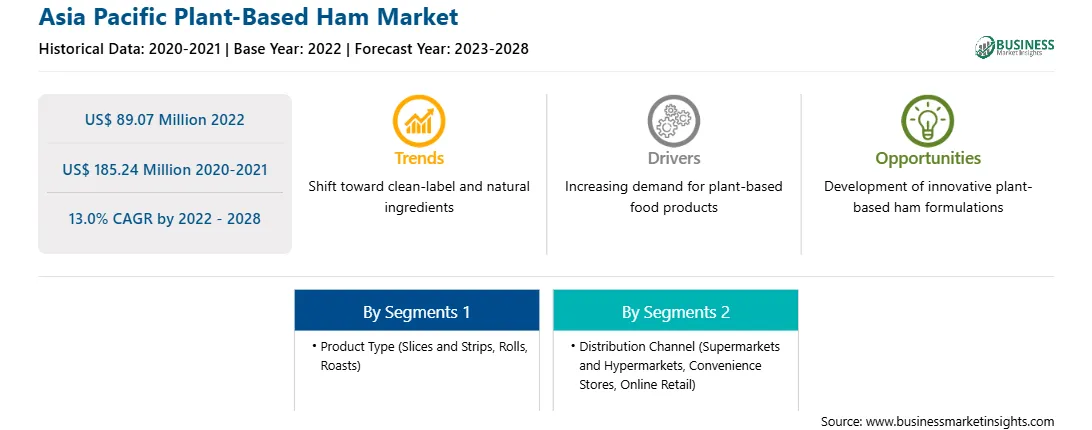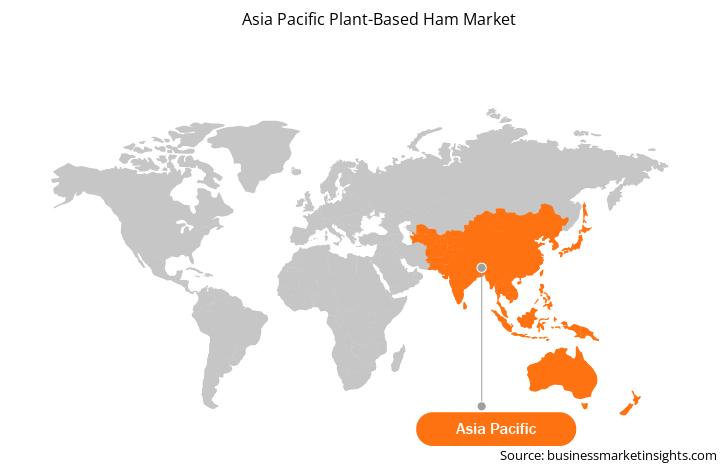亚太地区植物性火腿市场预测至 2028 年 – COVID-19 影响和区域分析 – 按产品类型(切片和条、卷和烤肉)和分销渠道(超市和大卖场、便利店、在线零售) , 和别的)
No. of Pages: 93 | Report Code: BMIRE00028091 | Category: Food and Beverages
No. of Pages: 93 | Report Code: BMIRE00028091 | Category: Food and Beverages
产品创新将推动亚太植物火腿市场
植物火腿制造商正在产品创新方面进行大量投资提供有机、无麸质、非转基因和无过敏原的产品来吸引大量消费者。此外,他们还使用大豆和豌豆蛋白以外的植物蛋白来使自己的产品与竞争对手区分开来。植物火腿制造商也在开发满足当地消费者需求的产品。例如,猪肉是亚洲消费最多的肉类之一;然而,该地区经营植物性猪肉的制造商数量有限。因此,像OmniPork这样的初创公司于2018年进入亚洲,在运营的头两年,该产品不仅在香港本土,而且在新加坡、澳门、中国内地、泰国、台湾等地取得了巨大的增长。自 1 月份推出以来,新猪肉产品每周售出约 100 万份。这些发展预计将大幅增加对植物火腿的需求。
亚太地区植物火腿市场概况
亚洲太平洋植物火腿市场进一步细分为澳大利亚、中国、日本、韩国和亚太其他地区。除了消费者的健康意识外,宗教信仰也促进了该地区对植物性肉类产品的需求。过量摄入动物性食品与饮食相关疾病有关,包括肥胖、2 型糖尿病、心脏病和癌症。据“国际糖尿病联合会 (IDF)”称,印度2019年有7700万糖尿病患者,是全球第二大糖尿病人口国家;到 2030 年,这一人口预计将达到 1.01 亿。根据 IDF 数据,2019 年中国约 1.14 亿成年人患有糖尿病。随着糖尿病和其他类似疾病的高患病率,消费者越来越意识到健康的重要性饮食和积极的生活方式,导致公众对包括火腿在内的植物性产品更加关注。 2020年12月,雀巢; SA 在中国以 Harvest Gourmet 品牌推出了一系列新的植物性熟食肉。该产品线包括火腿、萨拉米香肠和香肠的无肉替代品。食品中微生物污染引起的疾病病例不断增加,例如猪肉中的旋毛虫病、家禽中的沙门氏菌、羔羊中的痒病、鱼类中的弧菌病和诺如病毒感染,正在推动消费者倾向于植物性替代品。此外,城市中产阶级忙碌的生活方式以及个人饮食中营养的缺乏是支持亚太地区植物火腿市场增长的其他因素。
;
< strong>
亚太地区植物性火腿市场细分
亚太地区植物火腿市场按产品类型、分销渠道和国家/地区进行细分。
< /p>
根据产品类型,亚太地区植物性火腿市场分为片火腿、条火腿、卷火腿和烤火腿。 2022年,切片和条状细分市场在亚太植物性火腿市场中占据最大份额。
根据分销渠道,亚太地区植物性火腿市场分为超市和大卖场、便利店、在线零售等。 2022 年,超市和大卖场在亚太地区植物性火腿市场中占据最大份额。
按国家/地区划分,亚太地区植物火腿市场分为澳大利亚、中国、日本、韩国和亚太地区其他地区。 2022 年,中国市场在亚太地区植物性火腿市场中占据最大份额。
Hain Celestial 加拿大 ULC;曼特拉食品泰国有限公司; Meliora 食品有限公司;雀巢公司;阔恩食品有限公司;和 VBites Foods Ltd 是亚太地区植物火腿市场的领先公司。
Strategic insights for Asia Pacific Plant-Based Ham involve closely monitoring industry trends, consumer behaviours, and competitor actions to identify opportunities for growth. By leveraging data analytics, businesses can anticipate market shifts and make informed decisions that align with evolving customer needs. Understanding these dynamics helps companies adjust their strategies proactively, enhance customer engagement, and strengthen their competitive edge. Building strong relationships with stakeholders and staying agile in response to changes ensures long-term success in any market.

| Report Attribute | Details |
|---|---|
| Market size in 2022 | US$ 89.07 Million |
| Market Size by 2028 | US$ 185.24 Million |
| Global CAGR (2022 - 2028) | 13.0% |
| Historical Data | 2020-2021 |
| Forecast period | 2023-2028 |
| Segments Covered |
By 产品类型
|
| Regions and Countries Covered | 亚太地区
|
| Market leaders and key company profiles |
The regional scope of Asia Pacific Plant-Based Ham refers to the geographical area in which a business operates and competes. Understanding regional nuances, such as local consumer preferences, economic conditions, and regulatory environments, is crucial for tailoring strategies to specific markets. Businesses can expand their reach by identifying underserved regions or adapting their offerings to meet regional demands. A clear regional focus allows for more effective resource allocation, targeted marketing, and better positioning against local competitors, ultimately driving growth in those specific areas.

The Asia Pacific Plant-Based Ham Market is valued at US$ 89.07 Million in 2022, it is projected to reach US$ 185.24 Million by 2028.
As per our report Asia Pacific Plant-Based Ham Market, the market size is valued at US$ 89.07 Million in 2022, projecting it to reach US$ 185.24 Million by 2028. This translates to a CAGR of approximately 13.0% during the forecast period.
The Asia Pacific Plant-Based Ham Market report typically cover these key segments-
The historic period, base year, and forecast period can vary slightly depending on the specific market research report. However, for the Asia Pacific Plant-Based Ham Market report:
The Asia Pacific Plant-Based Ham Market is populated by several key players, each contributing to its growth and innovation. Some of the major players include:
The Asia Pacific Plant-Based Ham Market report is valuable for diverse stakeholders, including:
Essentially, anyone involved in or considering involvement in the Asia Pacific Plant-Based Ham Market value chain can benefit from the information contained in a comprehensive market report.